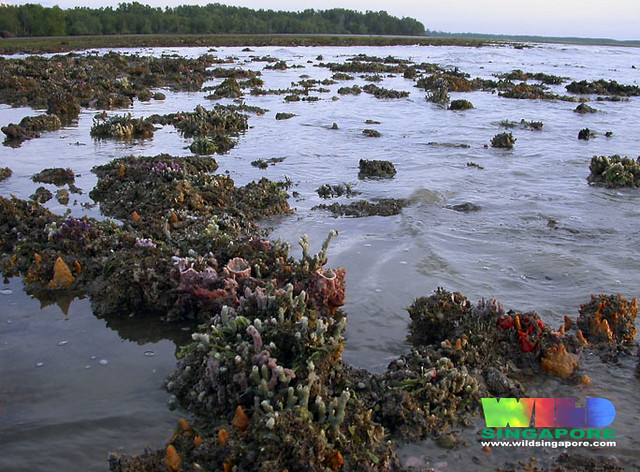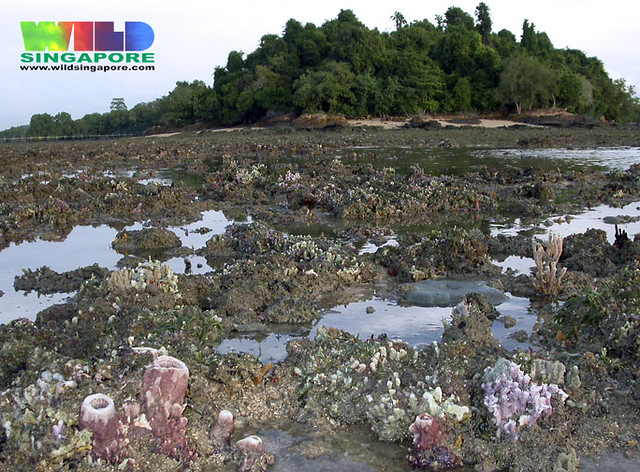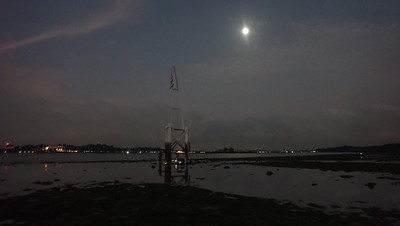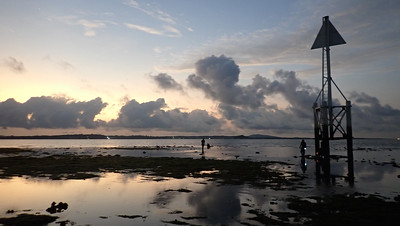The delicate coral garden here still thrives! With flowery soft corals, sea fans and colourful sponges of all kinds. I also saw a few signs of dugong feeding trails, on the way back from the shore, James spotted a mousedeer!
As on our Jun 2021 survey, the edge near the beacon was a Spiky flowery soft coral garden! With many small colonies in pretty pastel colours. There were also some Pink flowery soft corals. In the seagrass areas, there were Ball flowery soft corals.
There were sponges of various kinds along the survey route from the House No. 1 Jetty to the Chek Jawa Front Beacon. I first noticed improved sponge diversity during our survey in Jul 2016, which improved further during our Jun 2017, Jul 2018 and Jul 2019 surveys. The well developed clusters of Barrel sponges were still there. Today I continued to see a wide variety of sea fans. These include common ones like Candelabra sea fans, Gnarled sea fans, But also less commonly seen ones like Asparagus sea fan, and white Sea whips.
Echinoderms are still abundant on this shore. I saw 1 large Knobbly sea star and 2 small ones - a good sign as it shows the population is reproducing well. There were also some small 8-armed sand stars and 1 young Cake sea star. As usual, there were only a few Thorny and Pink warty sea cucumbers - not as abundantly as seen on Changi. I also saw many large white sea urchins. There are still a few large Common sea stars on a small sandy patch at Chek Jawa, we first saw them in Aug 2020. Before the 2007 mass deaths, they were so abundant, you could hardly walk on some parts of Chek Jawa if you wanted to avoid stepping on them. After more than a decade of absence, let's hope they are coming back for good.
It was great to see many small Biscuit sea stars. We have missed seeing them for at Chek Jawa and Pulau Sekudu for while.
Near the beacon, I saw about 20 small to medium sized Boulder pore corals. Most were a nice and healthy brown. A few had pale or dead portions. I saw two small colonies of Boulder sandpaper coral, 1 was partially bleaching while the other was alright. I also saw one healthy medium sized Flowery disk coral and many small patches of Zebra coral.
During our last survey in Jul 2021, the area looks more and more like what I used to see nearly 20 years ago! Today, it seems similar to what we saw last year. But I sense the sponge situation is better at Pulau Sekudu this year.
Although the sponge situation seems the better since the Big Flood of 2007. I feel it's not quite reached what I saw in the past.
 |
| Chek Jawa July 2002 |
 |
| Chek Jawa July 2002 (before the boardwalk was built) |
As we were leaving the shore, James spotted a mousedeer in the coastal forest! There were also many wild boar foraging on the shore.
Flaring at petrochemical plants at Pengerang Johor lit up the night sky during our predawn survey. It continued burning after sunrise. We saw the flaring too, during last month's survey of the Lost Coast and Pulau Sekudu. There was a bicycle frame directly under the jetty at House No. 1 and a pile of two large tyres along the southern sand bar. They have been for a long while and animals have started growing on them. Fortunately, today we didn't come across any fish nets or traps.
What is the fate of Chek Jawa?
Chek Jawa and Pulau Sekudu is slated for reclamation in the Long-Term Plan Review. The plan includes a road link (black line) from the mainland jumping off at Punggol, crossing to Pulau Ubin through Chek Jawa to jump off to Pulau Tekong before circling back to the mainland on Changi East. Proposed reclamation (in yellow) will bury Pasir Ris shores, Pulau Sekudu and Chek Jawa as well as a large stretches of Changi Beach.
The Singapore Blue Plan 2018
Among the Proposed Areas for Immediate Conservation Priority, the Singapore Blue Plan 2018 proposes that the intertidal and subtidal marine areas of Pulau Ubin to be designated Marine Reserve.
The proposed area would include Tanjung Chek Jawa, the largest known intertidal area in northern Singapore. Considered one of the richest in Singapore, Chek Jawa comprises many adjacent ecosystems: coastal hill forest, mangrove areas, rocky shores, seagrass meadows, coral communities, and sandy areas. Chek Jawa remains an icon of celebration and hope for many Singaporeans since its reprieve from reclamation in 2001.
DOWNLOAD the Plan, SUPPORT the Plan! More on the Singapore Blue Plan 2018 site.
Photos by others on this trip
Richard Kuah
James Koh
Kelvin Yong
Vincent Choo
Che Cheng Neo
Tammy Lim
Tang Yong Jen
Jonathan Tan










